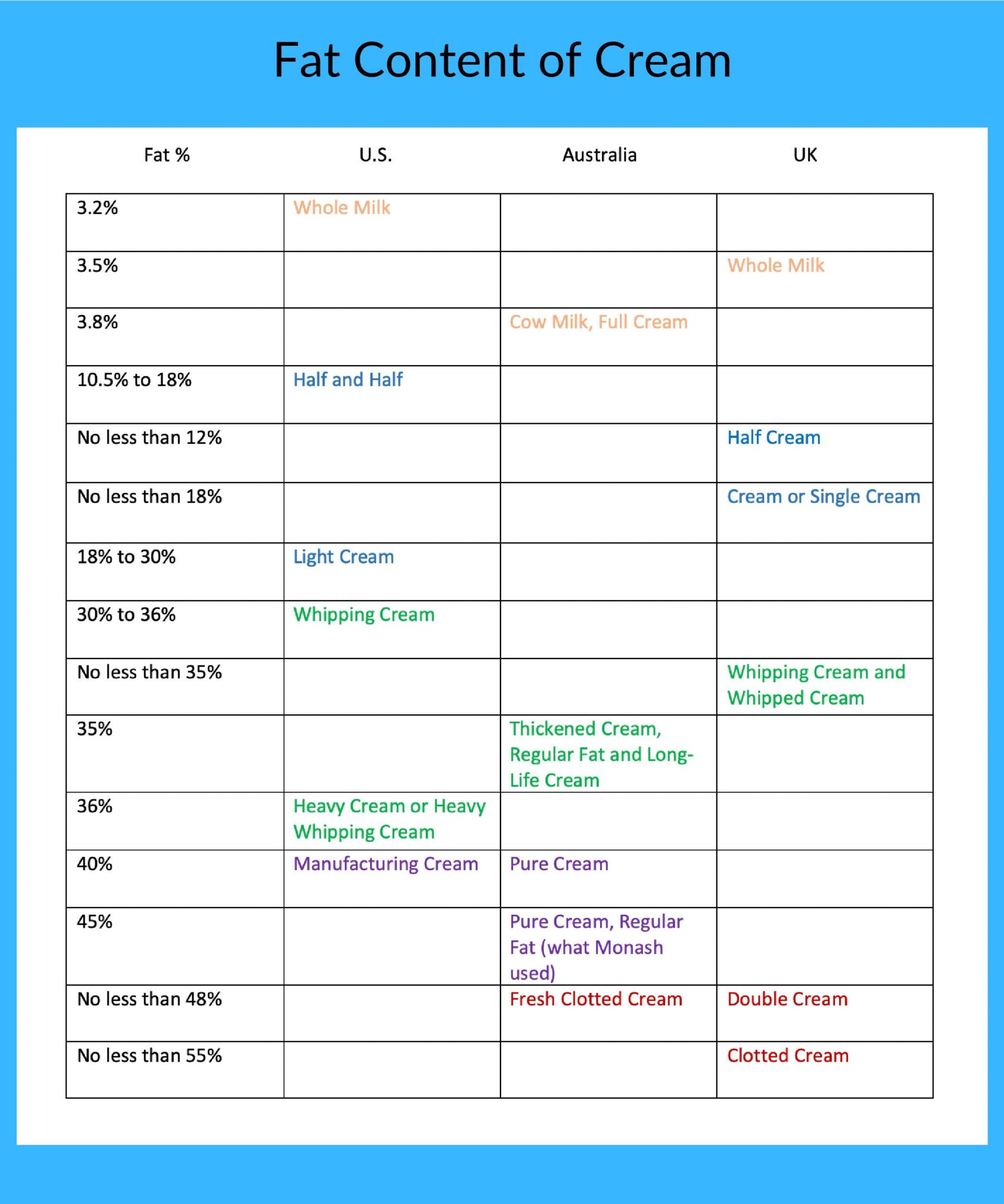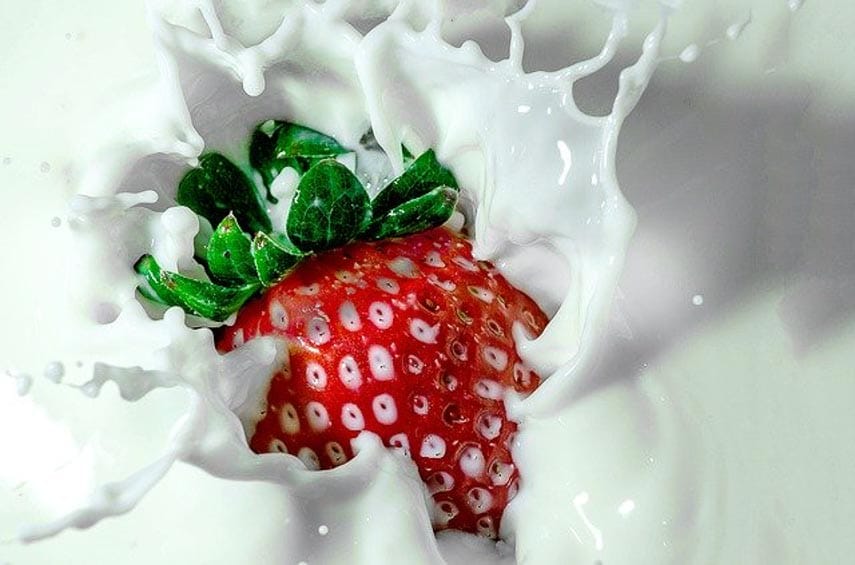Cream! This article is all about cream and FODMAPs because we love using various types of cream in savory sauces, to crown our desserts and hot cocoa with dollops of whipped cream, we use it to make ice cream and frozen desserts as well as in many a sweet recipe. And, since cream terminology is different in various countries, we will address that as well so that you can cook our recipes with success from various parts of the world.

Cream In The U.S., UK & Australia
We will cover the creams that are available in the U.S., as those are the ones that we use in our recipe development, and then explain what the equivalents would be in Australia and the UK.
We have also included some information on the richer creams (clotted, double, etc.) available in the UK and Australia, even though they have no U.S. equivalent.
What Is Cream?
Fresh, unpasteurized milk separates with the fat rising to the top. This fat is skimmed off and is known as cream.
Cream is used in all kinds of cooking and baking applications, enriching soups, sauces and gravies, whipped to top desserts or to be folded into mousses or other desserts. Lighter creams are popular in coffee.
It is the level of fat that distinguishes one cream from another – such as light cream vs. heavy cream – and dictates how rich that cream is. The higher the butterfat content, the richer the cream. Heavy cream whips well due to its high fat content, which is why you cannot whip light cream or half and half.
Butterfat/Milkfat/Milk Fat
The terms butterfat, milkfat and milk fat are used interchangeably depending on where you live. They all just refer to the fat in dairy products (like butter as well).
Cream & FODMAPs
FODMAPs are carbohydrates and many creams, especially those very high in fat, have fewer carbohydrates. In fact, if you look at a label for heavy cream in the U.S. you will see that per FDA serving, which is 1 tablespoon, that the carbohydrates are just 1 g and 0%. This is a low enough amount of lactose to be considered low FODMAP.
But we often use more than 1 tablespoon of cream and we want to know what would still be considered low FODMAP.
You will see as you read on that there is a bit of confusion when we jump from country to country in cream nomenclature and what the FODMAP content might be.
Types Of Cream By Milkfat
Here we discuss the various creams available in the U.S., the UK and Australia followed by a chart that also details some additional cream information. I am not including soured products such as crème fraiche or sour cream or pressurized products.
U.S. Creams
These are the creams that we call for in our recipes, in order from lower fat percentage to greatest:
Half-and-Half: This cream product is half whole milk and half light cream (see below) with 10.5% to 18% milkfat. It does not whip but it is very popular in coffee because of its relatively lower fat content but richer body and mouthfeel than whole milk alone.
Light Cream: Light cream contains 18% to 30% milkfat and is sometimes referred to as “table cream”. It will not whip but works very well in savory and sweet dishes, such as enriching soups, bisques and gravies.
Whipping Cream: This cream contains 30% to 36% milk fat. It whips and if you are looking for the ultimate, creamy, silky whipped cream to top desserts, this is our preference. It might not hold up as long or as stiffly as Heavy Cream (below) but its texture is even silkier.
Heavy Cream: Labels might also say “heavy whipping cream”. There is no less than 36% milkfat in this cream, and it whips very well. If you want fairly stiff peaks to hold up, then use this cream. You can use it for homemade whipped cream but note the comment above in Whipping Cream.
Manufacturing Cream (special mention): Manufacturing cream is actually the heaviest cream in the U.S. with over 40% fat, but it is usually only available through commercial food-service channels, hence we are mentioning it, although you could go a lifetime and never see it as a home cook. If you find some and want a very stable whipped cream, by all means try it out.
UK Creams
These are the creams commonly used in the UK, in order from lower fat percentage to greatest:
Half Cream: This product contains no less than 12% milkfat and is lovely in coffee and poured over berries.
Cream or Single Cream: This contains around 18% milkfat content. It will not whip and is somewhere between a rich half-and-half or a leaner light cream, per milkfat percentages.
Whipping Cream: With no less than 35% milkfat content, this is similar to heavy cream in the U.S. and would have the same applications.
Double Cream: This is the heaviest cream with around 48% milkfat content. There is no U.S. equivalent.
Australian Creams
For Australian creams we are going to do something a little different here due to the fact that many people have questions about the creams that are listed on the Monash University smartphone app – and want to know what their equivalents might be in the U.S. and also what their milkfat content is. Technical information is from Dairy Australia.
Their statement on cream: “Cream is categorized according to its milk fat content and comes in two forms – pure and treated. Both must contain no less than 35% milk fat.” Treated refers to the fact that some creams might contain thickening agents such as gelatin or gums, which make it easier to whip and less likely to separate or curdle.
Australian Creams As Described by Monash
Here are the creams listed in the Monash app, using their terminology. Note that where no milliliters, grams, Moderate or High FODMAP information is given, it is because it has not been provided. There are no liquid creams tested by FODMAP Friendly.
Cow Milk, Full Cream: Low FODMAP at 1 Australian tablespoon or 20 g. Becomes Moderate at ¼ cup (60 ml) or 60 g. This is somewhat equivalent to whole milk in the U.S. but is listed here since Monash uses the “cream” word in the app listing (which they did to distinguish it from low fat milks). This product contains 3.8% milkfat, while in the U.S. whole milk is 3.25% according to the USDA.
Thickened Cream, Regular Fat: Low FODMAP at 1 ½ Australian tablespoons or 30 g. Becomes Moderate at 2 Australian tablespoons or 40 g. Contains about 35% to 36.8% milkfat. Thickened cream typically contains additives such as gelatin, vegetable gum and/or other modifiers. Monash has told us that the cream they tested was 35% milkfat.
Whipped Cream: Low FODMAP at ½ cup (125 ml) or 60 g. Becomes Moderate at 2 cups or 200 g and High FODMAP at 4 cups (400 g). Monash has told us that they created this whipped cream with Thickened Cream, Regular Fat that was 35% milkfat.
Pure Cream, Regular Fat: Low FODMAP at 2 Australian tablespoons or 40 g. Becomes Moderate at ¼ cup or 63 g and High FODMAP at 1 cup (250 ml) or 257 g. In Australia pure cream doesn’t usually contain any thickening agents and typically has a fat content of around 35.9% to 40%. Monash has told us that the cream they tested was 45% milkfat.
Fat Percentages & Nomenclature
The following chart shows the fat percentage in various creams and what they are called in the U.S., Australia and the UK. I have created groupings by color, across countries, of products that you could try as equivalents of the others; individual results in recipes will vary.

Observations About Monash’s Take On Whipped Cream
Once we put all the math down, we realized that there are a few things that don’t make sense at first.
First, we must make sure we understand three very important fact that will help us understand the creams listed on the Monash app:
- Australian Regular Fat Thickened Cream at 35% milkfat is the best equivalent for Whipping Cream, Heavy Cream, or Heavy Whipping Cream here in the U.S. In the UK the equivalent is Whipping Cream.
- Cream doubles in volume when whipped.
- Entries in the Monash app often take “Australian healthy eating guidelines” into consideration. This means that sometimes an entry in the app is presented in its designated amount not only due to FODMAPs (or sometimes not at all, as with Sugar), but also due to these healthy eating guidelines.
The Math Examined
We suspect the ½ cup low FODMAP designation for Whipped Cream on the Monash app is possibly due to “Australian healthy eating guidelines” given the huge gap between the low FODMAP ½ cup and that it doesn’t become Moderate for FODMAPs until 2 cups. Meaning, you very well may be able to eat more than ½ cup and have it remain low FODMAP. Also, the small print in the app entry says the larger portions should be avoided if you “malabsorb lactose”. Lactose malabsorption is above and beyond regular FODMAP issues.
Then, since we know that Monash used 35% Regular Fat Thickened Cream to create their whipped cream (this was disclosed to us privately), this is where some more math falls apart.
The low FODMAP amount of Whipped Cream weighs 60 g according to Monash. This means that 60 g of the cream in its fluid state would be low FODMAP as well, but according to the app, Monash says that only 1 ½ tablespoons of Regular Fat Thickened Cream at 30 g is low FODMAP. This doesn’t add up.
Since we know that cream doubles when whipped, if ½ cup (60 g) whipped is low FODMAP, then ¼ cup liquid would be low FODMAP, but that is not what the app says.
How Much “Heavy” Cream Is Low FODMAP?
Because of the contradictory information in the app, we are left to our own devices to determine what we think the low FODMAP amounts are of heavy cream (or its equivalent). Is it only 1 ½ Australian tablespoons (30 g)? Or is it ¼ cup, since if that were whipped you would get ½ cup of whipped cream and that IS the amount of whipped cream that is low FODMAP?
At its simplest, we can say that if you want to be conservative, stick with the 1 ½ Australian tablespoons or 30 g as listed in the app. If you want to push the limits a little, use our math above and try ¼ cup (60 ml; also 60 g), which is equal to the ½ cup (60 g) whipped that is documented as low FODMAP.
It is time to look at our article, Ask The Right Question: Is It Low FODMAP or Can I Tolerate This? which might further clarify our line of thinking.
Since we do not actually know what the maximum low FODMAP amount of heavy cream is (if we accept the math path we have laid out) then what we should look at is how much we can tolerate. And that will be different for every individual.
The goal of the diet is to eat as broadly as possible without triggering your IBS. Only you can assess this with a structured Elimination and Challenge Phase. Perhaps take a look at What Is A Low FODMAP Serving Size?
Fat & IBS
Fat is an IBS trigger for some people. If you know that fat adversely affects you, then cream will probably not make frequent appearances in your diet and a very conservative approach will be best. Always eat to YOUR tolerances.
Pasteurized vs. Ultra- Pasteurized
It is important to discuss pasteurization when discussing cream, because it can affect how cream whips and tastes.
Pasteurization is a physical process of quickly heating then cooling a food product to kill off the kinds of bacteria such as salmonella, listeria and E. Coli.
In the U.S. pasteurizing milk has been a law since 1987, and milk cannot be sold across state lines unless it’s been pasteurized. As of January 2019, only 12 states allow retail sales of unpasteurized milk, also called raw milk.
There are two kinds of pasteurization:
- High Temperature Short Time: Also referred to as HTST, or more commonly simply as “pasteurized”.
- Ultra-High Temperature: Also referred to as UHT or ultra-pasteurized.
Most creams that you will find in the conventional U.S. supermarket dairy case will be ultra-pasteurized. You can tell because it will be clearly labeled as such. This means that it has been exposed to high heat very briefly, which kills off microorganisms and therefore extends shelf-life. Typically, this is about 280°F (138°C) for a minimum of 2 seconds.
To some palates UHT creams can taste “cooked” and, quite importantly, the process can also affect its ability to whip. If you have ever had trouble whipping heavy cream, this could be the culprit. Try to find heavy cream labeled simply as pasteurized (not ultra-) and see if it whips more easily for you and if you prefer its flavor. It is getting easier and easier to find pasteurized cream, often locally produced, at markets such as Whole Foods and farmers markets. Or, straight from a dairy, if you are so lucky.
We love Organic Valley Heavy Cream, which is simply pasteurized and contains 36% milkfat.
Whipping Cream
As you have learned above, some creams whip and some don’t. There needs to be enough milkfat in a cream for it to whip.
In general, when whipping cream, enough air is whipped into the cream so that it doubles in volume from its liquid state.
For best results whipping cream, use a high fat cream and chilled utensils (bowls, beaters, etc.) will help as well.
Check out our recipe for Whipped Cream.
Additives: Stabilizer, Gelatin, Gums & More
Some creams are stabilized with gelatins or gums. None of these are a FODMAP issue and they can help your cream whip more easily and keep its whipped shape longer. If you want a less adulterated cream, look for products fresh from the dairy or many organic products have a simpler label.
Sometimes you want a more stabilized whipped cream, such as when you are topping a pie well-ahead of time (refrigerated of course).
If you want to create a stabilized cream at home, there are two routes: If sweetening it you can use confectioners’ sugar, as opposed to granulated, as confectioners’ sugar has a small amount of cornstarch added, which will act as a light stabilizer. BTW, this is what distinguishes confectioners’ sugar from powdered sugar (which is just sugar).
Buying Cream
As we have discussed, there are many choices to make depending on your needs and desires, from knowing what fat content is appropriate to choosing creams with or without additives.
Buying the right cream simply comes down to reading labels – and that includes the “sell-by-date” or “best-by-date”. Cream is very perishable, and it is one item where I will often reach around to the back of the stacked cartons to get the freshest batch with the best-by-date that is the furthest along.
Storing Cream
Cream, like milk, should be stored in the coldest part of the refrigerator, which usually means not the door. Use the dates on the cartons or bottles as a guide. In general, once opened, it should be used as quickly as possible. A simple smell test will alert you to whether it has gone off.
Freezing Cream
Heavier fat creams can be frozen most successfully, although you can try with lighter creams as well. Note that cream expands upon freezing, which means it is not recommended that you just pop the carton that it comes in into the freezer. If you have some leftover from a cooking project, you can freeze some in ice cube trays, freeze them, them place those in a zip top bag. When you want to reconstitute it, place the number of cubes that you want in a jar with lid. Allow to defrost in refrigerator, then shake very well before using in its liquid state or for whipping.
And Of Course – ICE CREAM!
We love ice cream and bet you do too. We have a huge article for you on How To Choose Low FODMAP Ice Cream!









Thickened cream and heavy or whipping cream are not the same thing, so I don’t think there is a contradiction here. Thickened cream is a lower fat cream product that has thickeners added to simulate the texture of full fat whipping cream. Thus, it has more “milk” in it and the thickening agents also likely affect the fodmap content as well.
Hi Lee, not sure if you were looking for feedback here. Happy to address your questions if you have any.
I feel I wasted my time reading this. I wanted to know about half-and-half, and you didn’t say anything about it in terms of FODMAP.
Hi Lucy, We have a chart depicting what fat percentages are in creams in the US, UK and AU. Math has to be done. One has to look at what creams have been lab tested, and milk as well, look at the low FODMAP amounts and calculate. No creams with similar carb percentages to half and half have been lab tested. Whole milk has a low FODMAP amount of 1 tablespoon. Pure cream has 2 tablespoons. You could guesstimate the serving size would be somewhere in the middle. Whether you can tolerate it or not is individual and will depend on your fat tolerance and lactose tolerance.